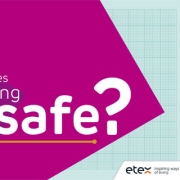Nigel Morrey, technical director at Siniat, discusses what EXAP is and why it is vital to removing ambiguity and ensuring robust building safety standards.
Last month, Michael Gove admitted pre-Grenfell cladding guidance was ‘faulty’ and ‘ambiguous’. While shocking to hear, for those of us who work in the construction industry, many of us had to agree.
Since Grenfell, the government has invested heavily into finding out what went wrong and ensuring such a tragedy never happens again. These actions have resulted in major tightening up of the fire safety guidance detailed in Approved Document B in 2019, yet it is still full of ambiguous footnotes, exceptions, and grey areas. So much so that Approved Document B is currently under consultation to discuss the removal of the national classification system for construction products (BS 476 series).
Ambiguity can lead to compromises on safety and questions around liability. The only way to achieve clarity and give specifiers the confidence they need to build safely is to cut out grey areas and eliminate differing national standards. EXAP holds the key to this.
What is EXAP?
EXAP means extended field of application and is the standard used to extend a fire test’s results to other similar systems – it is now referenced in Approved Dcoument B as the only recognised method of making these extensions or assessments.
The publication of the Hackitt report in 2018 played a major role in identifying failings within the construction industry’s regulations, codes, practices, and approval processes. This resulted in changes to Approved Document B to ensure fire safety legislation is more robust. The changes outlined that the industry should move away from testing systems for fire resistance to BS standards and instead ensure that systems are both tested and classified to the latest EN standards. This means following a process of ‘Test’, ‘Extend’, and ‘Classify’. First, testing must use the appropriate EN fire testing standard. Next, extension of test data to similar applications can be done, but only by qualified and approved 3rd party bodies using the test standard or extended application (EXAP) – and critically only where the standards explicitly allow it. Finally, this evidence must be validated and summarised in an official 3rd party classification report.
While more robust standards are vital, the challenge is that the updated guidelines in Approved Document B are more onerous than previous testing standards. They demand extensive additional testing, extension and classification of a manufacturer’s entire portfolio of systems, which is a laborious and expensive task. This process takes time – even years to complete. So, it is understandable that since 2019 the industry has been in a transitionary period.
The time is now
A transitionary period has been required to allow manufacturers to undertake the adequate testing and ensure the nation’s buildings are being built to the safest standards. However, four years down the line and with a question hanging over national classifications, we should no longer be seeing projects that require EXAP being specified to BS. It simply is not good enough. We know that the industry is serious about preventing the loss of property, and of life. So, we need to put that concern into action. Meeting the most up-to-date, robust, legislation is the best – and easiest – way to improve the safety of our buildings and give our partners and more importantly, the people who will live and work in the buildings we construct, the peace of mind they need.
To achieve this, a change in mindset is required. EXAP should now be seen as the minimum standard, whether or not the current consultation results in the removal of BS 476 recognition now, or in the future. Manufacturers have the power to enact this by ensuring their entire portfolio of systems meet these requirements. But organisations throughout the supply chain, including specifiers, have the responsibility to hold their manufacturers and suppliers accountable.
The Golden Thread
Liability is a huge concern within the industry and so it should be. Regulation 38 states that not only organisations can be held responsible, but individuals can be prosecuted too. In fact, any person responsible can be held liable retrospectively for up to 30 years since a build, and 15 years prospectively. So, demanding EXAP classification reports is crucial for ensuring that fire safety standards are taken seriously. If contractors, architects, and building control aren’t requesting adequate fire resistance information, it won’t become part of the project requirements and inevitably won’t be supplied, potentially exposing the client, designers and contractors to future issues. On top of this, the reports also help the industry to move towards the Golden Thread of information which is expected to become embedded in law within the next few years.
The Golden Thread has become a crucial way to increase transparency within the industry and show how every organisation contributing to the construction of a building has mitigated risk. It stipulates a need for an up to date, easily accessible and unbroken thread of information. The evidence found within EN and EXAP evidence ensures that fire safety information is supplied in a clear and consistent format, enabling the Golden Thread to be achieved more easily across the industry.
Requesting EXAP classification reports is vital to ensuring that as an industry we are moving towards safer processes and futureproofing our buildings. This will give construction professionals today, and tomorrow, the peace of mind that their building is safe.
www.siniat.co.uk


